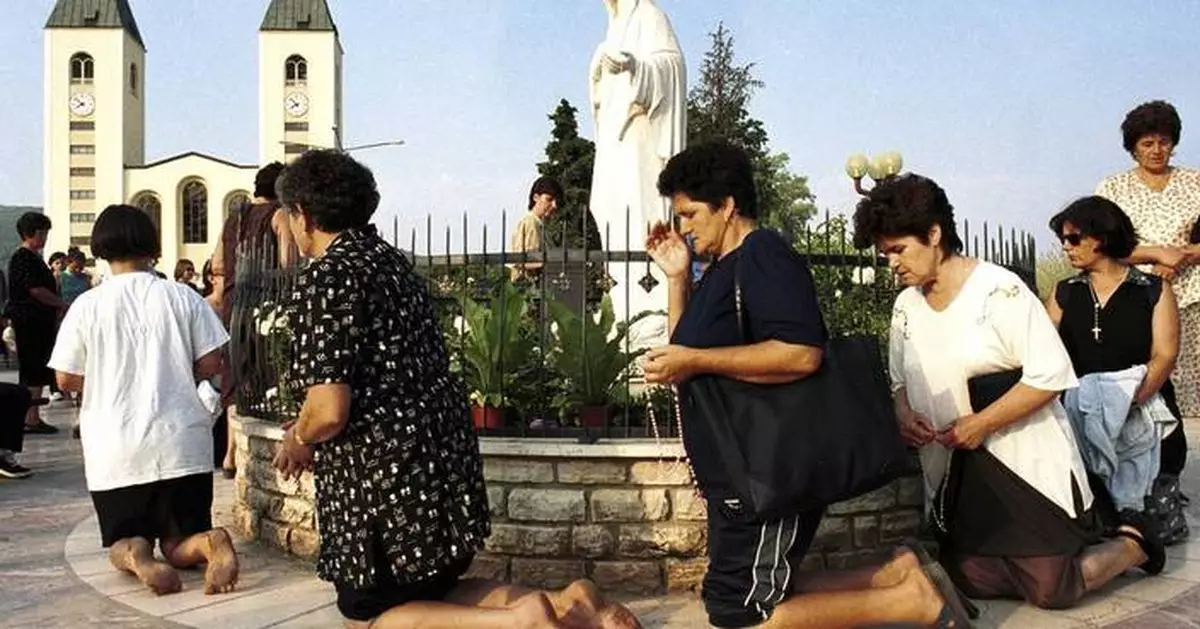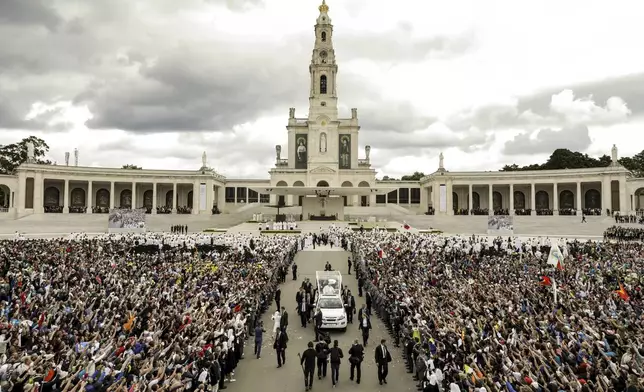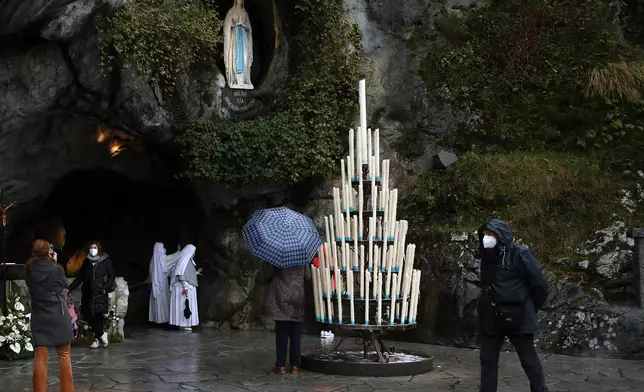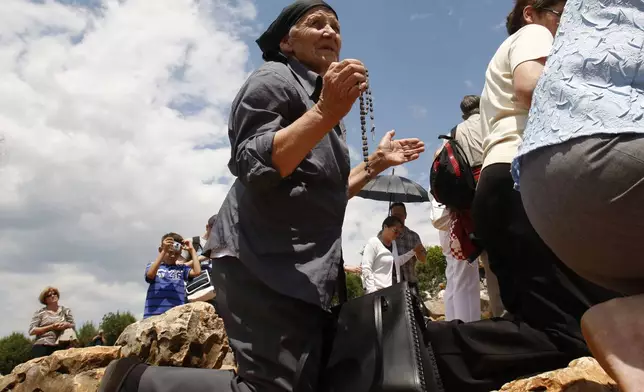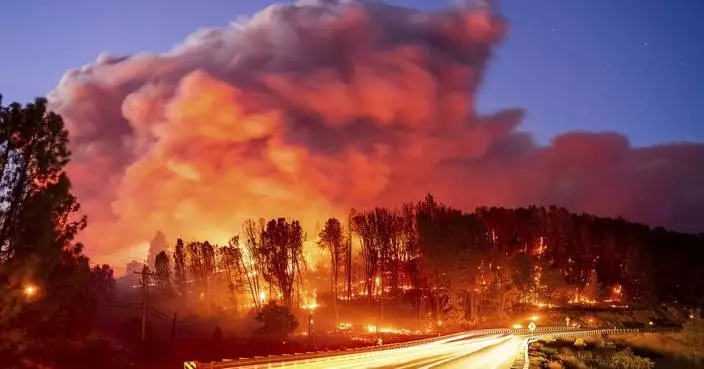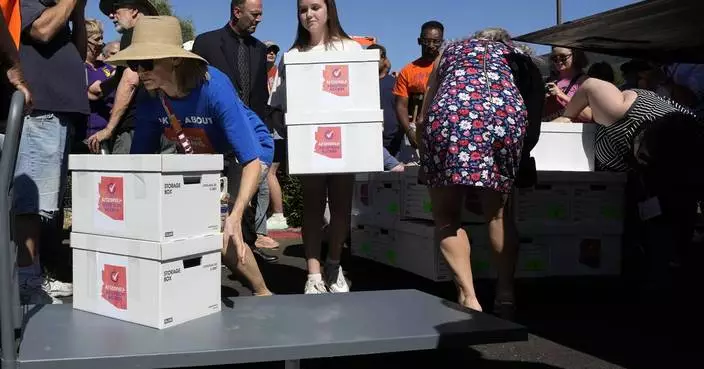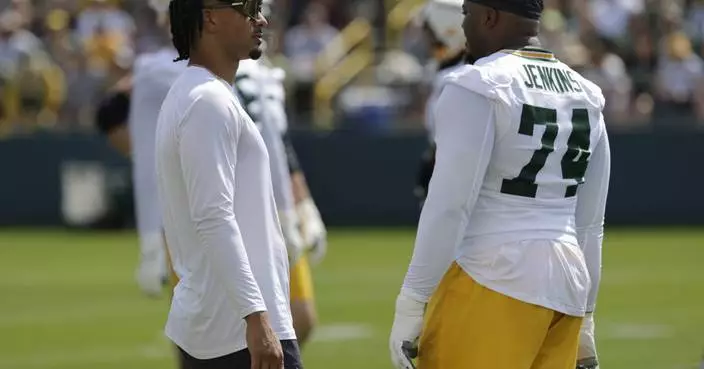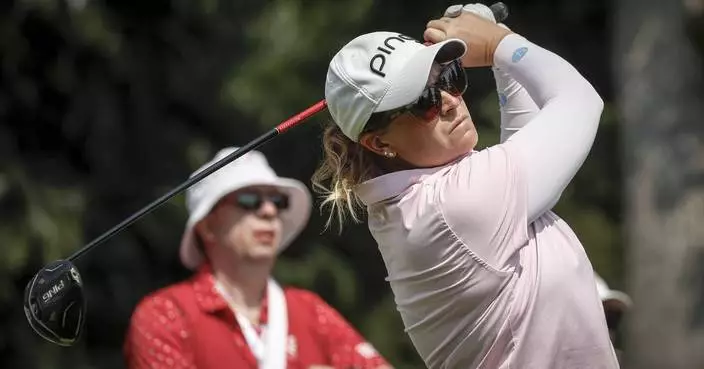VATICAN CITY (AP) — The Vatican on Friday radically reformed its process for evaluating alleged visions of the Virgin Mary, weeping statues and other seemingly supernatural phenomena that have long punctuated church history, putting the brakes on making definitive declarations unless the event is obviously fabricated.
The Vatican’s doctrine office overhauled norms first issued in 1978, arguing that they were no longer useful or viable in the internet age. Nowadays, word about apparitions or weeping Madonnas travels quickly and can actually harm the faithful if hoaxers are trying to make money off people's beliefs or manipulate them, the Vatican said.
Click to Gallery
Pilgrims walk on a rocky terrain to say their prayers on the Hill Of Appearance in Medjugorje,100 km south of Sarajevo, Monday, June 25, 2012, where it is believed that the Virgin Mary showed herself and conveyed messages of peace to six children on June 25, 1981. On Friday, May 17, 2024, the Vatican will issue revised norms for discerning apparitions "and other supernatural phenomena," updating a set of guidelines first issued in 1978. (AP Photo/Amel Emric, File)
Pilgrims say prayers at the 'Hill of Appearance' in the southern-Bosnian town of Medjugorje, 100 kms south of Sarajevo, on Friday, June 25, 2010, where it is believed that the Virgin Mary showed herself and conveyed messages of peace to six children on June 25, 1981. On Friday, May 17, 2024, the Vatican will issue revised norms for discerning apparitions "and other supernatural phenomena," updating a set of guidelines first issued in 1978. (AP Photo/Amel Emric, File)
A Franciscan friar blesses pilgrims as they kneel in prayer around a statue of the Virgin Mary at the Hill Of Appearance in the southern Bosnian town of Medjugorje,160 kms south of Sarajevo, Saturday, June 25, 2011, where it is believed that the Virgin Mary showed herself and conveyed messages of peace to six children on June 25, 1981. On Friday, May 17, 2024, the Vatican will issue revised norms for discerning apparitions "and other supernatural phenomena," updating a set of guidelines first issued in 1978. (AP Photo/Amel Emric, File)
VATICAN CITY (AP) — The Vatican on Friday radically reformed its process for evaluating alleged visions of the Virgin Mary, weeping statues and other seemingly supernatural phenomena that have long punctuated church history, putting the brakes on making definitive declarations unless the event is obviously fabricated.
Pilgrims pray at the Roman Catholic shrine in Lourdes, southwestern France, Friday, Feb.11, 2022. On Friday, May 17, 2024, the Vatican will issue revised norms for discerning apparitions "and other supernatural phenomena," updating a set of guidelines first issued in 1978. (AP Photo/Bob Edme, File)
Faithful light candles while visiting the Virgin of Guadalupe's Sanctuary to celebrate her day in Guatemala City on Thursday, Dec. 12, 2002. On Friday, May 17, 2024, the Vatican will issue revised norms for discerning apparitions "and other supernatural phenomena," updating a set of guidelines first issued in 1978. (AP Photo/Jaime Puebla, File)
Pilgrims walk on a rocky terrain to say their prayers on the Hill Of Appearance in Medjugorje,100 km south of Sarajevo, Monday, June 25, 2012, where it is believed that the Virgin Mary showed herself and conveyed messages of peace to six children on June 25, 1981. On Friday, May 17, 2024, the Vatican will issue revised norms for discerning apparitions "and other supernatural phenomena," updating a set of guidelines first issued in 1978. (AP Photo/Amel Emric, File)
Pilgrims say prayers at the 'Hill of Appearance' in the southern-Bosnian town of Medjugorje, 100 kms south of Sarajevo, on Friday, June 25, 2010, where it is believed that the Virgin Mary showed herself and conveyed messages of peace to six children on June 25, 1981. On Friday, May 17, 2024, the Vatican will issue revised norms for discerning apparitions "and other supernatural phenomena," updating a set of guidelines first issued in 1978. (AP Photo/Amel Emric, File)
A Franciscan friar blesses pilgrims as they kneel in prayer around a statue of the Virgin Mary at the Hill Of Appearance in the southern Bosnian town of Medjugorje,160 kms south of Sarajevo, Saturday, June 25, 2011, where it is believed that the Virgin Mary showed herself and conveyed messages of peace to six children on June 25, 1981. On Friday, May 17, 2024, the Vatican will issue revised norms for discerning apparitions "and other supernatural phenomena," updating a set of guidelines first issued in 1978. (AP Photo/Amel Emric, File)
Pilgrims walk around a statue of the Blessed Virgin Mary near the church of St. James in Medjugorje, Bosnia and Herzegovina, some 120 kilometers (75 miles) south of the Bosnian capital of Sarajevo on Sunday, June 25, 2006. On Friday, May 17, 2024, the Vatican will issue revised norms for discerning apparitions "and other supernatural phenomena," updating a set of guidelines first issued in 1978. (AP Photo/Amel Emric, File)
Bosnian Roman Catholic women pray on the occasion of the feast of the Assumption in Medjugorje, some 120 kilometers (75 miles) south of the Bosnian capital Sarajevo on Tuesday, August 15, 2000. Some 19 years ago six young people claimed Holy Mary appeared to them in the town of Medjugorje. On Friday, May 17, 2024, the Vatican will issue revised norms for discerning apparitions "and other supernatural phenomena," updating a set of guidelines first issued in 1978. (AP Photo/Hidajet Delic, File)
The new norms make clear that such an abuse of people's faith can be punishable canonically, saying, “The use of purported supernatural experiences or recognized mystical elements as a means of or a pretext for exerting control over people or carrying out abuses is to be considered of particular moral gravity.”
The Catholic Church has had a long and controversial history of the faithful claiming to have had visions of the Virgin Mary, of statues purportedly weeping tears of blood and stigmata erupting on hands and feet mimicking the wounds of Christ.
When confirmed as authentic by church authorities, these otherwise inexplicable signs have led to a flourishing of the faith, with new religious vocations and conversions. That has been the case for the purported apparitions of Mary that turned Fatima, Portugal, and Lourdes, France, into enormously popular pilgrimage destinations.
Church figures who claimed to have experienced the stigmata wounds, including Padre Pio and Pope Francis’ namesake, St. Francis of Assisi, have inspired millions of Catholics even if decisions about their authenticity have been elusive.
Francis himself has weighed in on the phenomenon, making clear that he is devoted to the main church-approved Marian apparitions, such as Our Lady of Guadalupe, who believers say appeared to an Indigenous man in Mexico in 1531.
But Francis has expressed skepticism about more recent events, including claims of repeated messages from Mary to “seers” at the shrine of Medjugorje in Bosnia-Herzegovina, even while allowing pilgrimages to take place there.
“I prefer the Madonna as mother, our mother, and not a woman who’s the head of a telegraphic office, who sends a message every day at a certain time,” Francis told reporters in 2017.
And the phenomena have also been a source of scandal. That was the case when the Vatican in 2007 excommunicated the members of a Quebec-based group, the Army of Mary, after its foundress claimed to have had Marian visions and declared herself the reincarnation of the mother of Christ.
The revised norms acknowledge the real potential for such abuses and warn that hoaxers will be held accountable, including with canonical penalties.
The new norms reframe the Catholic Church’s evaluation process by essentially taking off the table whether church authorities will declare a particular vision, stigmata or other seemingly divinely inspired event supernatural.
Instead, the new criteria envisages six main outcomes, with the most favorable being that the church issues a noncommittal doctrinal green light, a so-called “nihil obstat.” Such a declaration means there is nothing about the event that is contrary to the faith, and therefore Catholics can express devotion to it.
The bishop can take more cautious approaches if there are doctrinal red flags about the reported event. The most serious envisages a declaration that the event isn’t supernatural or that there are enough red flags to warrant a public statement “that adherence to this phenomenon is not allowed.”
The revised norms allow that an event might at some point be declared “supernatural,” and that the pope can intervene in the process. But “as a rule,” the church is no longer in the business of authenticating inexplicable events or making definitive decisions about their supernatural origin.
And at no point are the faithful obliged to believe in the particular events, said Argentine Cardinal Víctor Manuel Fernández, the head of the Vatican doctrine office.
“The church gives the faithful the freedom to pay attention” or not, he said at a news conference.
Despite the new criteria, he assured that the church's past decision-making on alleged supernatural events — such as at Fatima, Guadalupe or Lourdes — remains valid.
“What was decided in the past has its value,” he said. “What was done remains.”
Neomi De Anda, executive director of the International Marian Research Institute at the University of Dayton, said the new guidelines represent a significant but welcome change to the current practice, while restating important principles.
“The faithful are able to engage with these phenomena as members of the faithful in popular practices of religion, while not feeling the need to believe everything offered to them as supernatural as well as the caution against being deceived and beguiled,” she said in an email.
Whereas in the past the bishop often had the last word unless Vatican help was requested, now the Vatican must sign off on every recommendation proposed by a bishop.
Fernández acknowledged that the Vatican’s previous way of handling reported apparitions often led to “considerable confusion” among the faithful, as well as lengthy delays in reaching a definitive ruling. To date, fewer than 20 apparitions have been approved by the Vatican, according to Michael O’Neill, who runs the online apparition resource The Miracle Hunter.

Pope Francis in his popemobile leaves at the end of a Mass where he canonized shepherd children Jacinta and Francisco Marto at the Sanctuary of Our Lady of Fatima, Saturday, Friday, May 13, 2017, in Fatima, Portugal. On Friday, May 17, 2024, the Vatican will issue revised norms for discerning apparitions "and other supernatural phenomena," updating a set of guidelines first issued in 1978. (Paulo Novais/Pool Photo via AP, File)

Pilgrims pray at the Roman Catholic shrine in Lourdes, southwestern France, Friday, Feb.11, 2022. On Friday, May 17, 2024, the Vatican will issue revised norms for discerning apparitions "and other supernatural phenomena," updating a set of guidelines first issued in 1978. (AP Photo/Bob Edme, File)
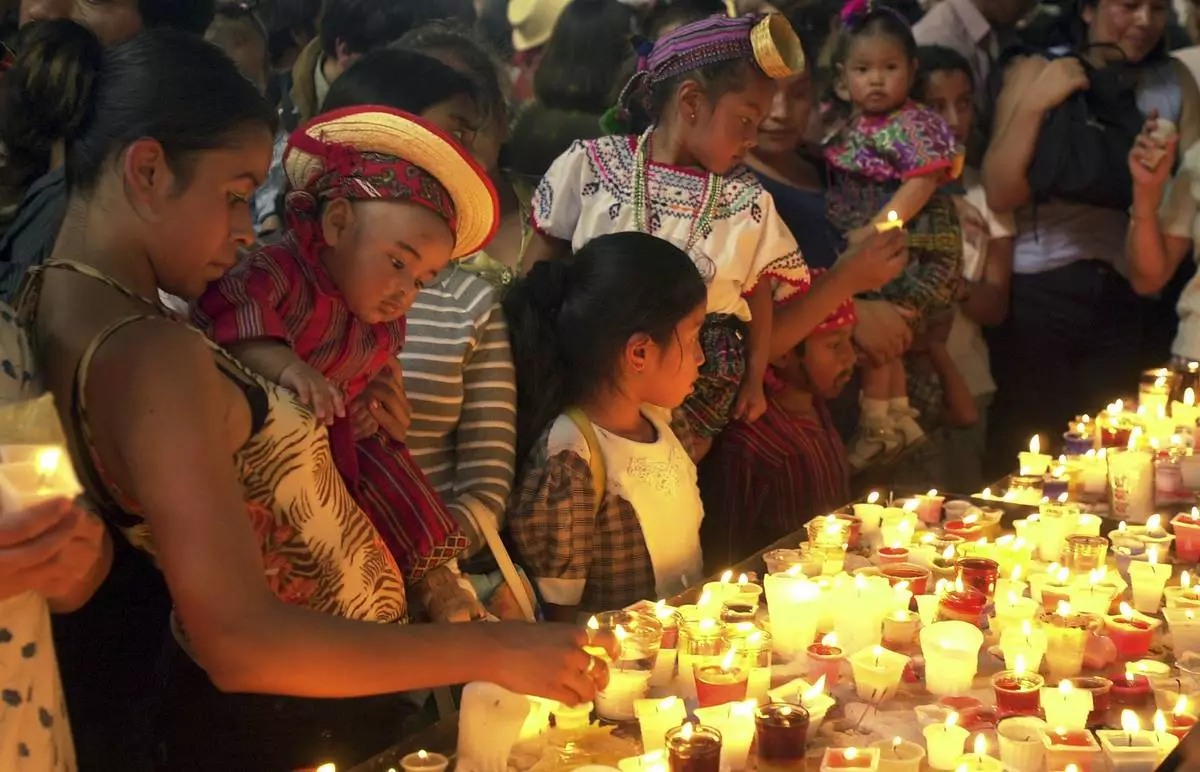
Faithful light candles while visiting the Virgin of Guadalupe's Sanctuary to celebrate her day in Guatemala City on Thursday, Dec. 12, 2002. On Friday, May 17, 2024, the Vatican will issue revised norms for discerning apparitions "and other supernatural phenomena," updating a set of guidelines first issued in 1978. (AP Photo/Jaime Puebla, File)
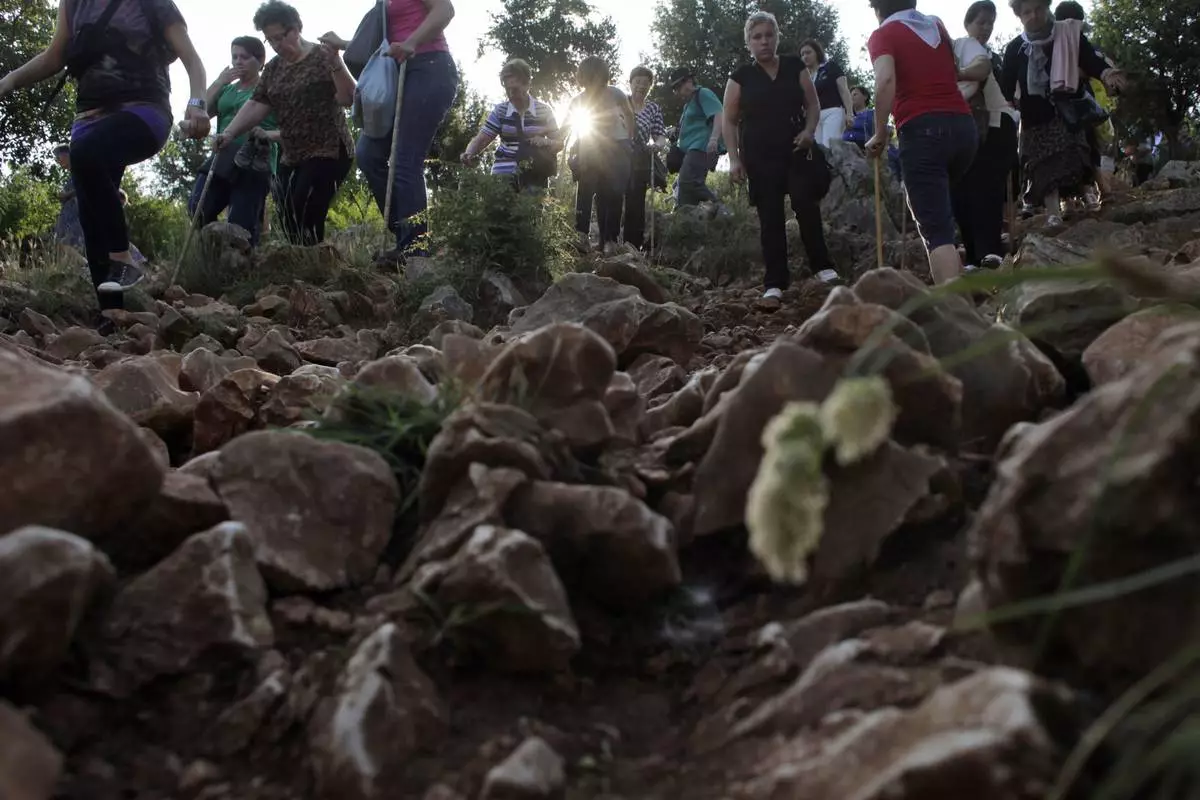
Pilgrims walk on a rocky terrain to say their prayers on the Hill Of Appearance in Medjugorje,100 km south of Sarajevo, Monday, June 25, 2012, where it is believed that the Virgin Mary showed herself and conveyed messages of peace to six children on June 25, 1981. On Friday, May 17, 2024, the Vatican will issue revised norms for discerning apparitions "and other supernatural phenomena," updating a set of guidelines first issued in 1978. (AP Photo/Amel Emric, File)

Pilgrims say prayers at the 'Hill of Appearance' in the southern-Bosnian town of Medjugorje, 100 kms south of Sarajevo, on Friday, June 25, 2010, where it is believed that the Virgin Mary showed herself and conveyed messages of peace to six children on June 25, 1981. On Friday, May 17, 2024, the Vatican will issue revised norms for discerning apparitions "and other supernatural phenomena," updating a set of guidelines first issued in 1978. (AP Photo/Amel Emric, File)
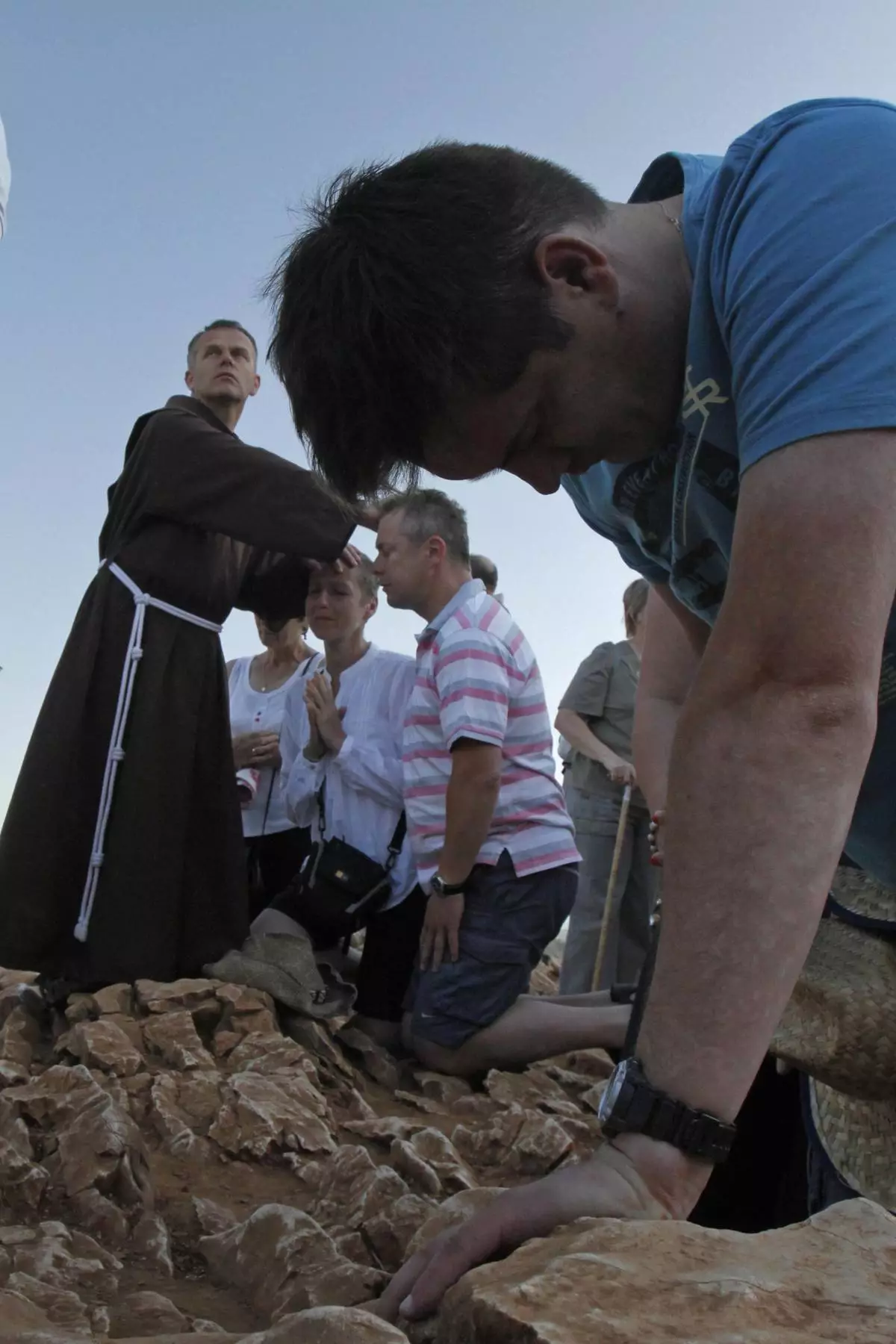
A Franciscan friar blesses pilgrims as they kneel in prayer around a statue of the Virgin Mary at the Hill Of Appearance in the southern Bosnian town of Medjugorje,160 kms south of Sarajevo, Saturday, June 25, 2011, where it is believed that the Virgin Mary showed herself and conveyed messages of peace to six children on June 25, 1981. On Friday, May 17, 2024, the Vatican will issue revised norms for discerning apparitions "and other supernatural phenomena," updating a set of guidelines first issued in 1978. (AP Photo/Amel Emric, File)
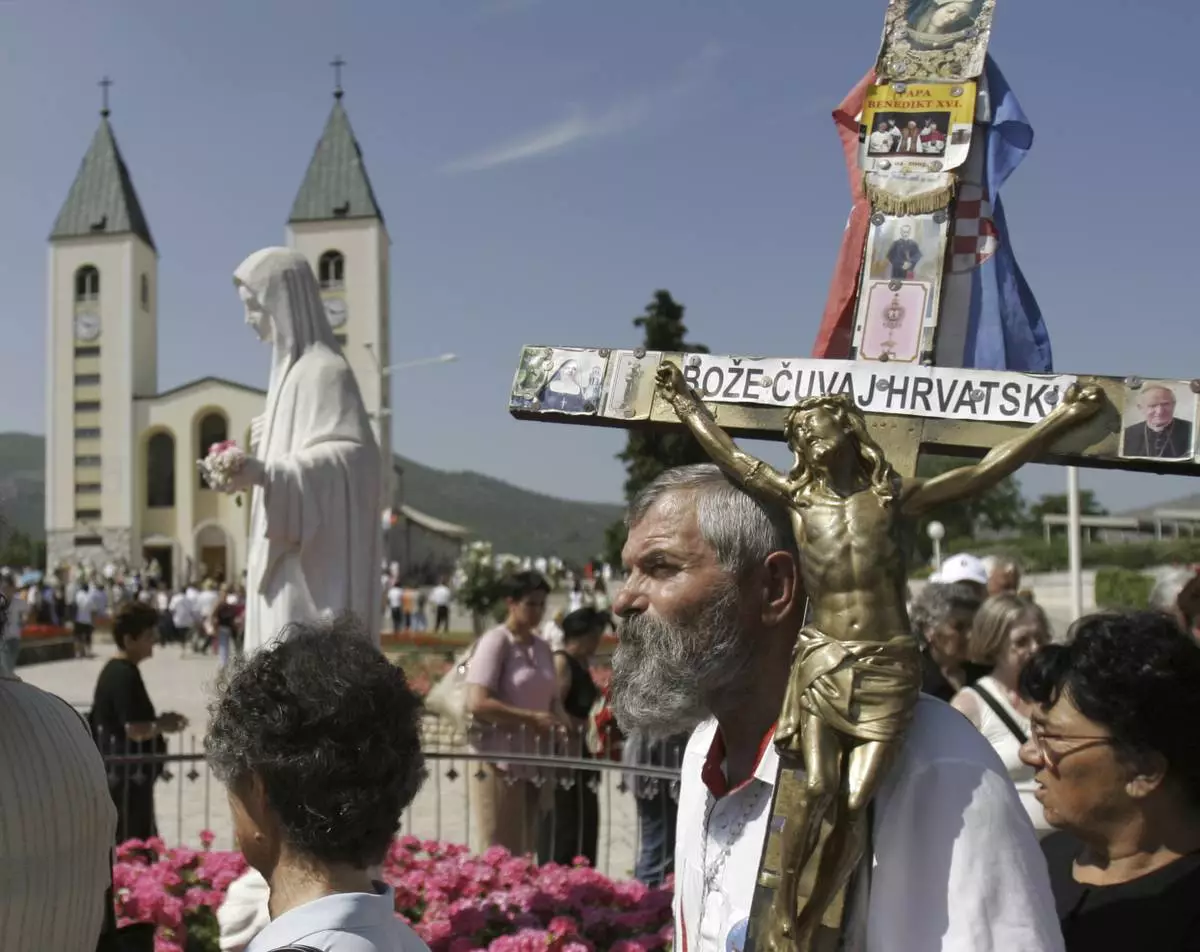
Pilgrims walk around a statue of the Blessed Virgin Mary near the church of St. James in Medjugorje, Bosnia and Herzegovina, some 120 kilometers (75 miles) south of the Bosnian capital of Sarajevo on Sunday, June 25, 2006. On Friday, May 17, 2024, the Vatican will issue revised norms for discerning apparitions "and other supernatural phenomena," updating a set of guidelines first issued in 1978. (AP Photo/Amel Emric, File)
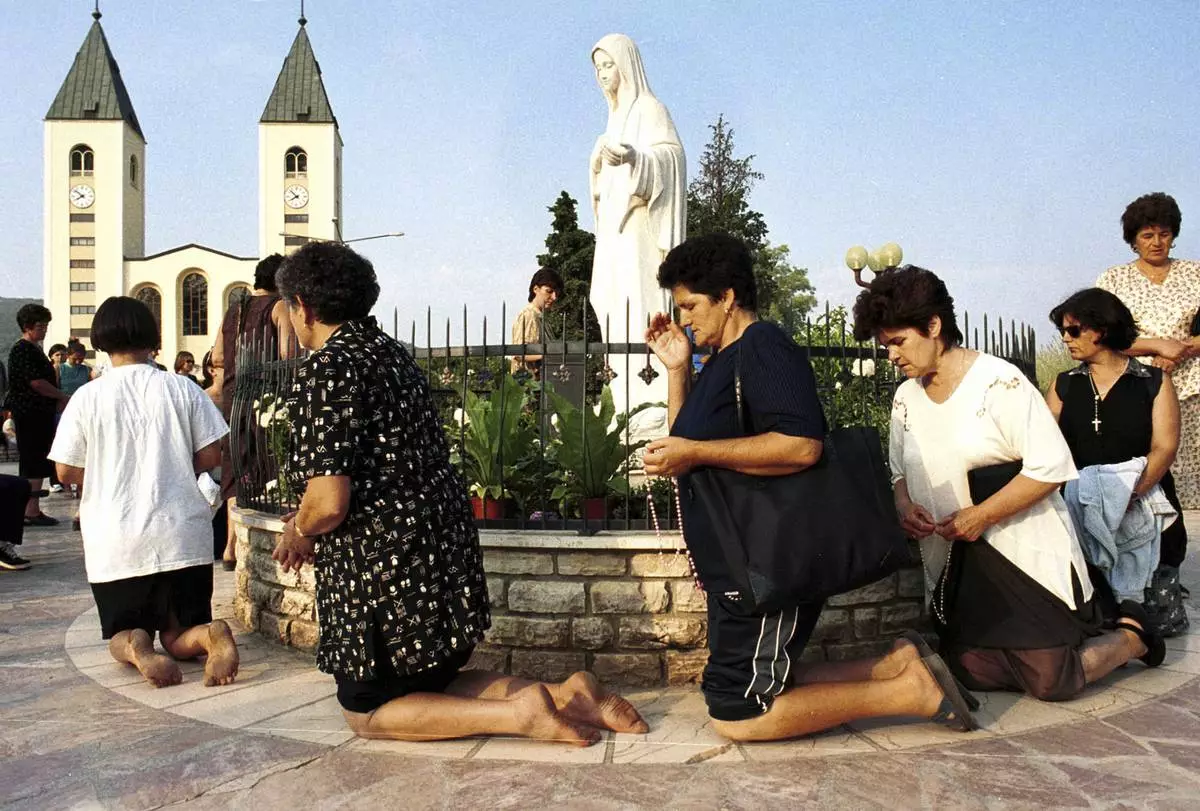
Bosnian Roman Catholic women pray on the occasion of the feast of the Assumption in Medjugorje, some 120 kilometers (75 miles) south of the Bosnian capital Sarajevo on Tuesday, August 15, 2000. Some 19 years ago six young people claimed Holy Mary appeared to them in the town of Medjugorje. On Friday, May 17, 2024, the Vatican will issue revised norms for discerning apparitions "and other supernatural phenomena," updating a set of guidelines first issued in 1978. (AP Photo/Hidajet Delic, File)
WASHINGTON (AP) — Nearly two weeks after Donald Trump’s near assassination, the FBI confirmed Friday that it was indeed a bullet that struck the former president’s ear, moving to clear up conflicting accounts about what caused the former president’s injuries after a gunman opened fire at a Pennsylvania rally.
“What struck former President Trump in the ear was a bullet, whether whole or fragmented into smaller pieces, fired from the deceased subject’s rifle,” the agency said in a statement.
The one-sentence statement from the FBI marked the most definitive law enforcement account of Trump’s injuries and followed ambiguous comments earlier in the week from Director Christopher Wray that appeared to cast doubt on whether Trump had actually been hit by a bullet.
The comment drew fury from Trump and his allies and further stoked conspiracy theories that have flourished on both sides of the political aisle amid a dearth of information following the July 13 attack.
Up until now, federal law enforcement agents involved in the investigation, including the FBI and Secret Service, had refused to provide information about what caused Trump’s injuries. Trump’s campaign has also declined to release medical records from the hospital where he was first treated or to make the doctors there available for questions.
Updates have instead come either from Trump himself or from Trump’s former White House doctor, Ronny Jackson, a staunch ally who now represents Texas in Congress. Though Jackson has been treating Trump since the night of the attack, he has come under considerable scrutiny and is not Trump’s primary care physician.
The FBI’s apparent reluctance to immediately vouch for the former president’s version of events has also raised fresh tension between the Republican nominee and the nation’s premier federal law enforcement agency, which he could soon exert control over once again. Trump and his supporters have for years accused federal law enforcement of being weaponized against him, something Wray has consistently denied.
Speaking at an event later Friday in West Palm Beach Florida, Trump drew boos from the crowd when he described the suggestion that he may have been struck by glass or shrapnel instead of a bullet.
“Did you see the FBI today apologized?" he asked. “It just never ends with these people. ... We accept their apology.”
Trump appeared Friday for the first time without a bandage on his right ear. Photographs and video showed no sign of continued bleeding, and no distinct holes or gashes.
Questions about the extent and nature of Trump’s wound began immediately after the attack, as his campaign and law enforcement officials declined to answer questions about his condition or the treatment he received after Trump narrowly escaped death in an attempted assassination by a gunman with a high-powered rifle.
Those questions have persisted despite photographs showing the trace of a projectile speeding past Trump’s head as well as Trump’s teleprompter glass intact after the shooting, and the account Trump himself gave in a Truth Social post within hours of the shooting that he had been “shot with a bullet that pierced the upper part of my right ear.”
“I knew immediately that something was wrong in that I heard a whizzing sound, shots, and immediately felt the bullet ripping through the skin,” he wrote.
Days later, in a speech accepting the nomination at the Republican National Convention in Milwaukee, Trump recounted the scene in detail, while wearing a large gauze bandage over his right ear.
“I heard a loud whizzing sound and felt something hit me really, really hard, on my right ear. I said to myself, ‘Wow, what was that? It can only be a bullet,’” he said.
“If I had not moved my head at that very last instant,” Trump said, “the assassin’s bullet would have perfectly hit its mark, and I would not be here tonight.”
But the first medical account of Trump’s condition didn’t come until a full week after the shooting, when Jackson released his first letter last Saturday evening. In it, he said the bullet that struck Trump had “produced a 2 cm wide wound that extended down to the cartilaginous surface of the ear.” He also revealed Trump had received a CT scan at the hospital.
Federal law enforcement involved in the investigation, including the FBI and Secret Service, had declined to confirm that account. And Wray’s testimony offered apparently conflicting answers on the issue.
“There’s some question about whether or not it’s a bullet or shrapnel that hit his ear,” Wray said, before he seemed to suggest it was indeed a bullet.
“I don’t know whether that bullet, in addition to causing the grazing, could have also landed somewhere else,” he said.
On Thursday, the FBI sought to clarify matters with a statement affirming that the shooting was an “attempted assassination of former President Trump which resulted in his injury, as well as the death of a heroic father and the injuries of several other victims.” The FBI also said Thursday that its Shooting Reconstruction Team continues to examine bullet fragments and other evidence from the scene.
Jackson, who has been treating the former president since the night of the July 13 shooting, told The Associated Press on Thursday that any suggestion Trump’s ear was bloodied by anything other than a bullet was reckless.
“It was a bullet wound,” said Jackson. “You can’t make statements like that. It leads to all these conspiracy theories.”
In his letter Friday, Jackson insisted “there is absolutely no evidence” Trump was struck by anything other than a bullet and said it was “wrong and inappropriate to suggest anything else.”
He wrote that at Butler Memorial Hospital, where the GOP nominee was rushed after the shooting, he was evaluated and treated for a “Gunshot Wound to the Right Ear.”
“Having served as an Emergency Medicine physician for over 20 years in the United States Navy, including as a combat physician on the battlefield in Iraq,” he wrote, “I have treated many gunshot wounds in my career. Based on my direct observations of the injury, my relevant clinical background, and my significant experience evaluating and treating patients with similar wounds, I completely concur with the initial assessment and treatment provided by the doctors at nurses at Butler Memorial Hospital on the day of the shooting.”
The FBI declined to comment on the Jackson letters.
Asked if the campaign would release those hospital records, or allow the doctors who treated him there to speak, Trump campaign spokesperson Steven Cheung blasted the media for asking.
“The media has no shame in engaging in disgusting conspiracy theories,” he said. “The facts are the facts, and to question an abhorrent assassination attempt that ultimately cost a life and injured two others is beyond the pale.”
In emails last week, he told the AP that “medical readouts” had already been provided.
“It’s sad some people still don’t believe a shooting happened,” Cheung said, “even after one person was killed and others were injured.”
Anyone who believes the conspiracies, he added, “is either mentally deficient or willfully peddling falsehoods for political reasons.”
Sen. Lindsey Graham, R-S.C., a close Trump ally, also urged Wray to correct his testimony in a letter Friday, saying the fact Trump had been hit by a bullet “was made clear in briefings my office received and should not be a point of contention.”
“As head of the FBI, you should not be creating confusion about such matters, as it further undercuts the agency’s credibility with millions of Americans,” he wrote.
Trump also lashed out at Wray in a post on his Truth Social network, saying it was “No wonder the once storied FBI has lost the confidence of America!”
“No, it was, unfortunately, a bullet that hit my ear, and hit it hard. There was no glass, there was no shrapnel,” he wrote.
On Friday, he called Wray’s comments “so damaging to the Great People that work in the FBI.”
Jackson has encountered significant scrutiny over the years.
After administering a physical to Trump in 2018, he drew headlines for suggesting that “if he had a healthier diet over the last 20 years, he might live to be 200 years old.”
He was reportedly demoted by the Navy after the Department of Defense inspector general released a scathing report on his conduct as a top White House physician that found Jackson had made “sexual and denigrating” comments about a female subordinates and took prescription-strength sleeping medication that prompted worries from his colleagues about his ability to provide proper medical care.
Trump appointed Wray as FBI director in 2017 to replace the fired James Comey. But the then-president swiftly soured on his hire as the bureau continued its investigation into the Russian election interference.
Trump flirted openly with the idea of firing Wray as his term drew to a close, and he lashed out anew after the FBI executed a search warrant at his Mar-a-Lago estate in Florida to recover boxes of classified documents from his presidency.
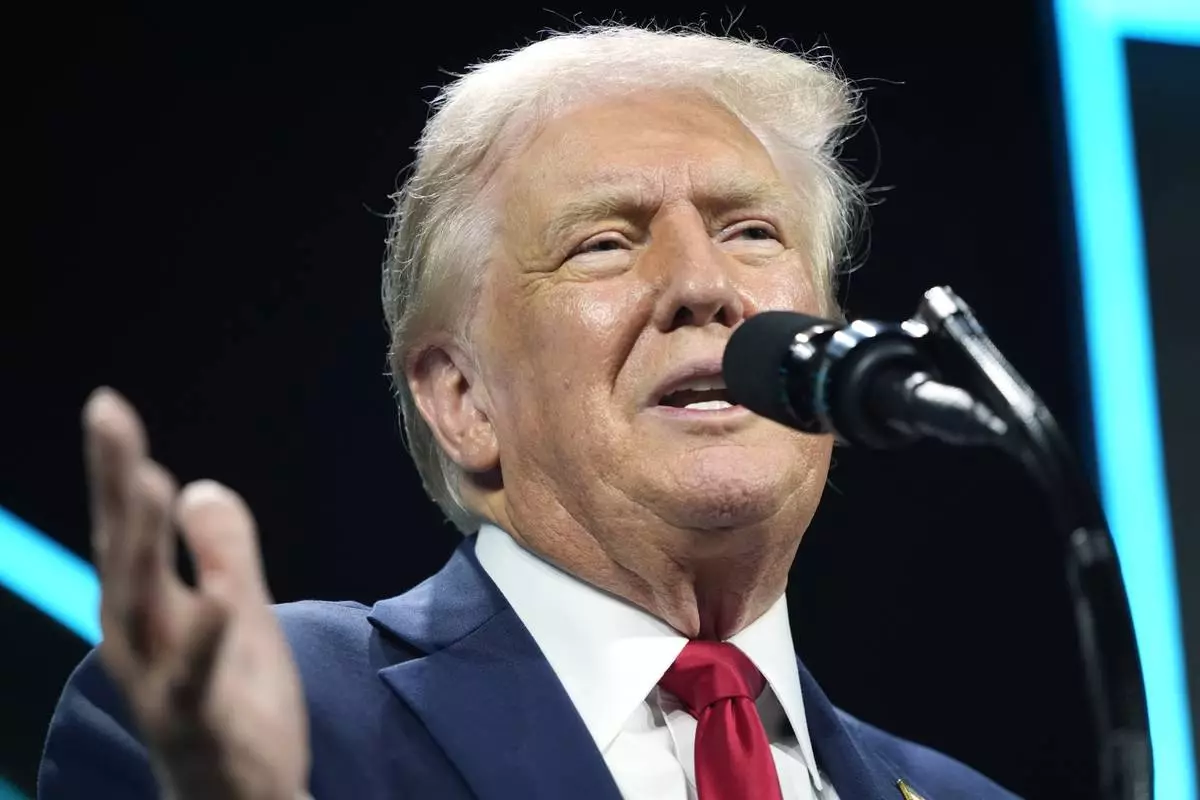
Republican presidential candidate former President Donald Trump speaks at the Turning Point Believers' Summit, Friday, July 26, 2024, in West Palm Beach, Fla. (AP Photo/Alex Brandon)

FBI Director Christopher Wray testifies before a House committee about the July 13 shooting at a campaign rally in Butler, Pennsylvania, Wednesday, July 24, 2024, on Capitol Hill. Wray said that the FBI will "leave no stone unturned" in its investigation of the attempted assassination of former President Donald Trump. (AP Photo/Manuel Balce Ceneta)

Republican presidential candidate former President Donald Trump, speaks during the Republican National Convention, Thursday, July 18, 2024, in Milwaukee. (AP Photo/Julia Nikhinson)
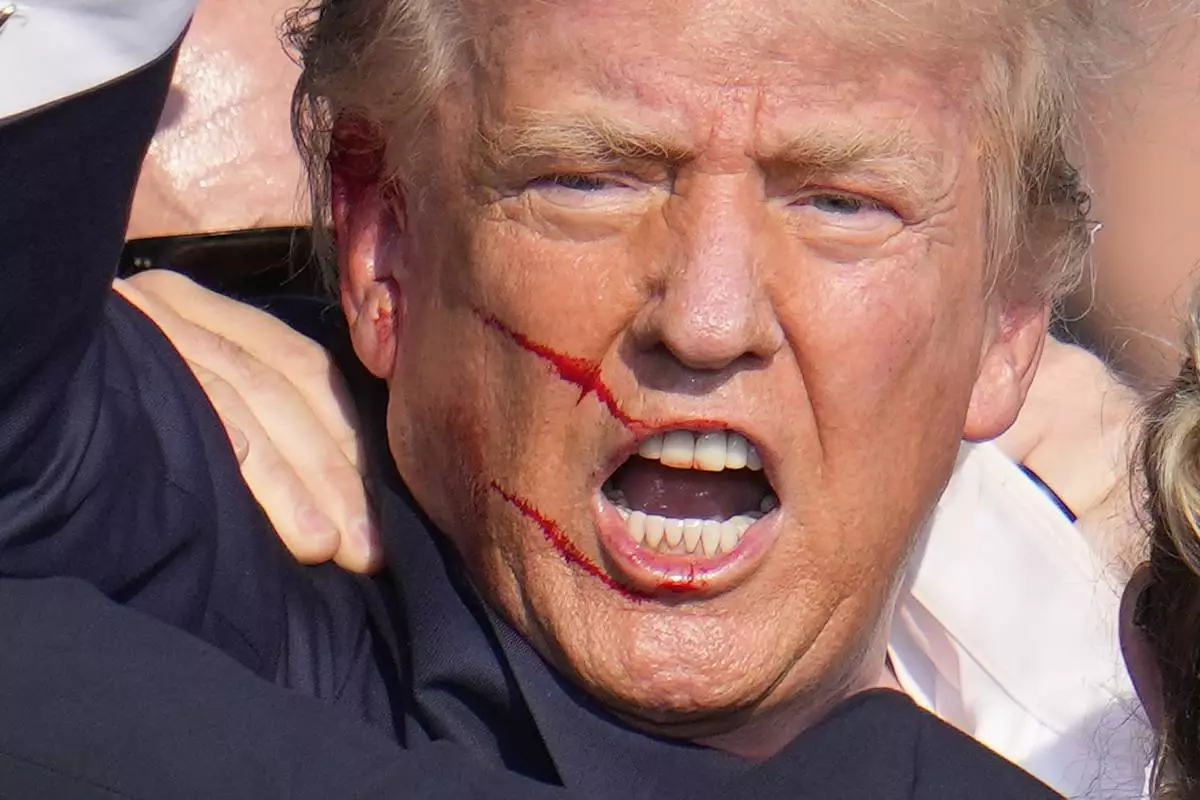
Republican presidential candidate former President Donald Trump reacts following an assassination attempt at a campaign event in Butler, Pa., on Saturday, July 13, 2024. (AP Photo/Gene J. Puskar)
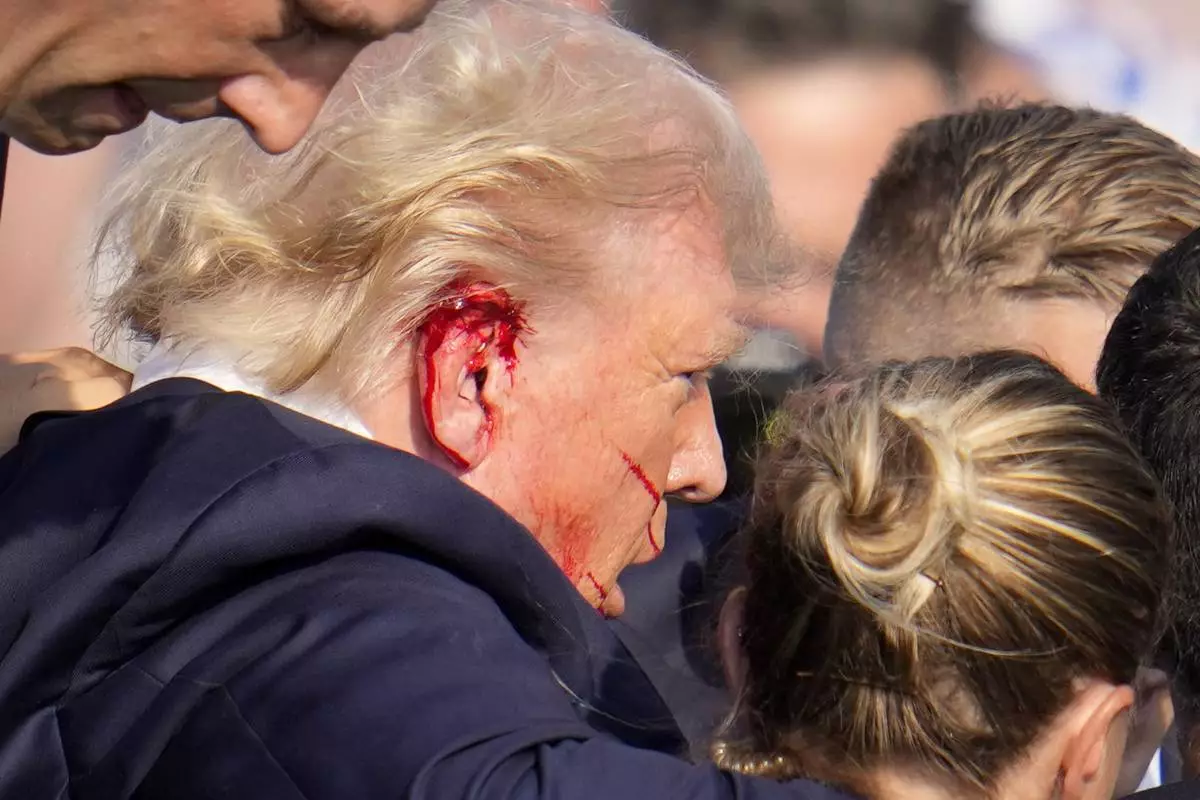
Republican presidential candidate former President Donald Trump is escorted to a motorcade following an attempted assassination at a campaign event in Butler, Pa., on Saturday, July 13, 2024. (AP Photo/Gene J. Puskar)










